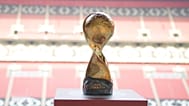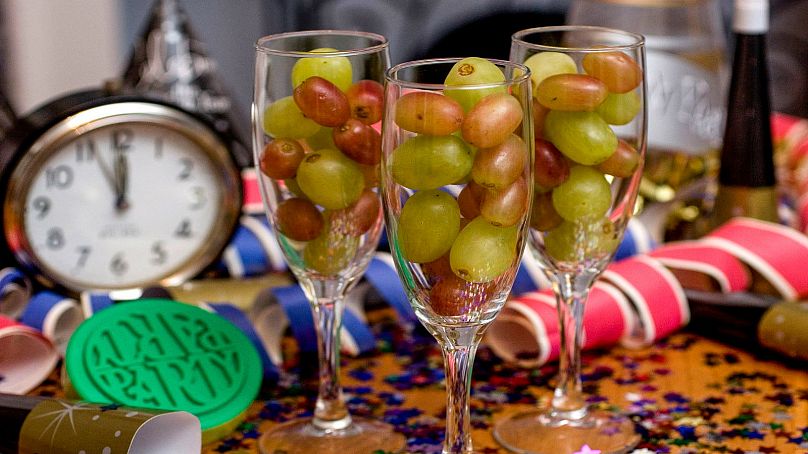How does Europe bring in the New Year? Euronews staff tell us how they celebrate in their home countries.
How does Europe bring in the New Year? From smashing pomegranates to donning red underwear, poultry avoidance to Bulgarian whipping boys, Euronews staff tell us how New Year's Eve is celebrated in their home countries.
Greece and Cyprus: Marios Ioannou
In Greece and Cyprus we prepare Vasilopita, a traditional New Year’s cake, on December 31st. You put a coin inside the cake and after midnight we cut it. Whoever finds the coin gets good luck and you have to keep it in your wallet so it will be full of money all year long.
We also hang a pomegranate, an ancient symbol of prosperity and good luck, above the door over Christmas. Then at midnight on New Year’s Eve, the lights are turned out and the pomegranate is hurled at the door – when it smashes, spilling out its seeds, the more seeds the more luck, health, happiness and prosperity for the coming year.
Hungary: Noemi Mrav
Hungary has traditional dishes for New Year’s Eve, which include salty cakes, roasted pig, lentil soup and sausage. But you’ll never catch a Hungarian eating poultry for New Year’s Eve, because chickens are said to “scratch the good luck”.
Otherwise, we celebrate New Year's Eve with trumpets (children and drunk people tend to start this up well before midnight) and when the clock strikes 12 everyone listens to the national anthem on television, standing with a glass of Champagne in hand until the end when we clink glasses and wish each other a happy new year. Then the president makes a televised speech, which most people watch, then we phone our loved ones to wish them good luck for the year ahead.
Scotland: Lindsey Johnstone
New Year's Eve is called Hogmanay in Scotland and it's as big a deal as Christmas (which, thanks to Presbyterianism, only became a public holiday in 1958). We have massive street parties – Edinburgh's is among the biggest in the world – and at the stroke of midnight you link arms with whoever is next to you and sing Auld Lang Syne, a Robert Burns poem.
Then comes first footing where you visit your friends and neighbours - and the first person in your house after midnight is a forecast for your year ahead. If a tall, dark man is your first visitor it's good luck, whereas a fair-haired woman is a bad omen. You should bring a lump of coal with you and say "Lang may yer lum reek" (meaning long may your chimney smoke, a wish for a long and happy life) – and a bottle of whisky, for obvious reasons.
On the 1st of January we do what's called the Loony Dook – running into the North Sea. There's a mass event held in the Firth of Forth, just outside Edinburgh, but any freezing cold stretch of sea will do.
Italy: Luca Santocchia
Italian traditions include eating lentils and cotechino (a large pork sausage) at midnight. This tradition originates from the ancient Roman custom of giving a "scarsella" (a leather bag) tied to the belt and containing lentils, with the wish that they would be transformed into coins. The name lentil, in fact, derives from the particular shape of these legumes, which resembles that of a coin. Italians also wear red underwear to bring good luck for the coming year.
Spain: Rafa Cereceda
On Nochevieja, or "old night," the last day of the year in Spain, 12 grapes are eaten at midnight – one at each stroke of the clock, for good luck for each of the coming 12 months. This tradition is a century or so old, although its exact origins are debatable – one theory that abounds is that growers in Alicante in 1909 found themselves with a bumper harvest and came up with a creative way to sell off their surplus.
And as in Italy, red underwear should be worn to enhance the luck-bestowing properties of the grapes – preferably some given to you by someone else.
While Cava, mostly produced in Catalonia, is the traditional drink with which to toast the new year, last year there were calls to boycott "the Champagne of Spain" due to the independence dispute – a move which the big Cava brands said did have an impact on sales.
Germany: Linda Fischer
Two things are traditionally important for New Year in Germany: lead and fireworks. Usually New Year's Eve starts off relaxed, family and friends usually meet at one person's home. Often they eat raclette or fondue. Afterwards, games are played – Monopoly and parlour games. The highlights of the evening are lead casting and fireworks.
For the lead casting, one heats a spoon with lead over a flame. As soon as it is liquid, you tip it into a bowl of water – the shape it takes decides your future. A bee means danger, a rocking horse a fateful turn... but lead has been banned this year, thanks to the EU.
Then people go out for the fireworks. Everyone fires New Year's Eve rockets into the air – which amounts to a huge gold mine for manufacturers. There are rockets for €10, but you can easily spend more than €100.
It is also a very common tradition to watch a British comedy sketch from 1963 called Dinner For One, which, thanks to becoming a staple of the German [and Danish, Austrian, Swedish, Finnish and Norwegian] New Year's Eve television schedule, is now the most frequently repeated television programme of all time. I highly recommend it for those who don't know it.
Denmark: Ole Krogsgaard
In Denmark, there are two sacred moments on New Year's Eve: 6 p.m. and 12 a.m. At 6 p.m., the Queen does her annual speech to the people – everybody gathers in front of the television and the first sparkling wine is consumed.
Then we eat – the classic New Year’s dish is cod – and drink. At 11.40 p.m., almost everybody will gather in front of the telly to watch Dinner for One, of course.
At 11.59 p.m., we climb up on chairs, waiting for the town hall bells to start chiming live on TV. That signals that it’s midnight, when we leap from the chair and into the new year. We might even kiss the cheek of the person standing next to us – that’s a big deal in Denmark! Then it’s outside to set off fireworks.
The next day, a more modern tradition implores us to nurse our hangover by eating junk food and watching the New Year ski jump at Garmisch-Partenkirchen, always transmitted live by our national broadcaster.
Bulgaria: Michael Fiorentino
Survakane is an ancient ritual that's still very popular in which children slap the backs of their family members with a decorated stick known as a survaknitsa on the morning of New Year's Day – known in Bulgarian as Vasilovden.
The sticks are made from strong branches and can vary in size. Children proudly decorate their own survaknitsa with popcorn, flowers and yarn and then take turns "knighting" family and friends and wishing them well in the upcoming year.
While doing this, they recite a poem wishing their relative good health for the new year – their reward afterwards is candy, or small amounts of money.
Russia: Naira Davlashyan
New Year is the most important holiday of the year in Russia, more widely celebrated than Christmas. The New Year bank holiday in Russia lasts from January 1st to January 8th – nobody has to work in that time.
Russian New Year's dinner is full of odd dishes like "herring in a coat". This is a layer of pickled herring, then a layer of mayo, a layer of chopped potatoes, another layer of mayo, a layer of beetroot, another layer of mayo...
People get all cheerful and shout Happy New Year ("S novym godom!") out of their windows and to strangers in the streets. We make wishes at midnight – some people write their wishes on a piece of paper, burn it, stir the ashes into a glass of Champagne and then drink it up before the Kremlin chimes strike midnight. It is also customary to watch Putin's New Year address.
Plus, Russia is spread over 11 time zones, so, in theory, if you travel from Kamchatka to Kaliningrad you could manage to have 11 New Year parties.
















